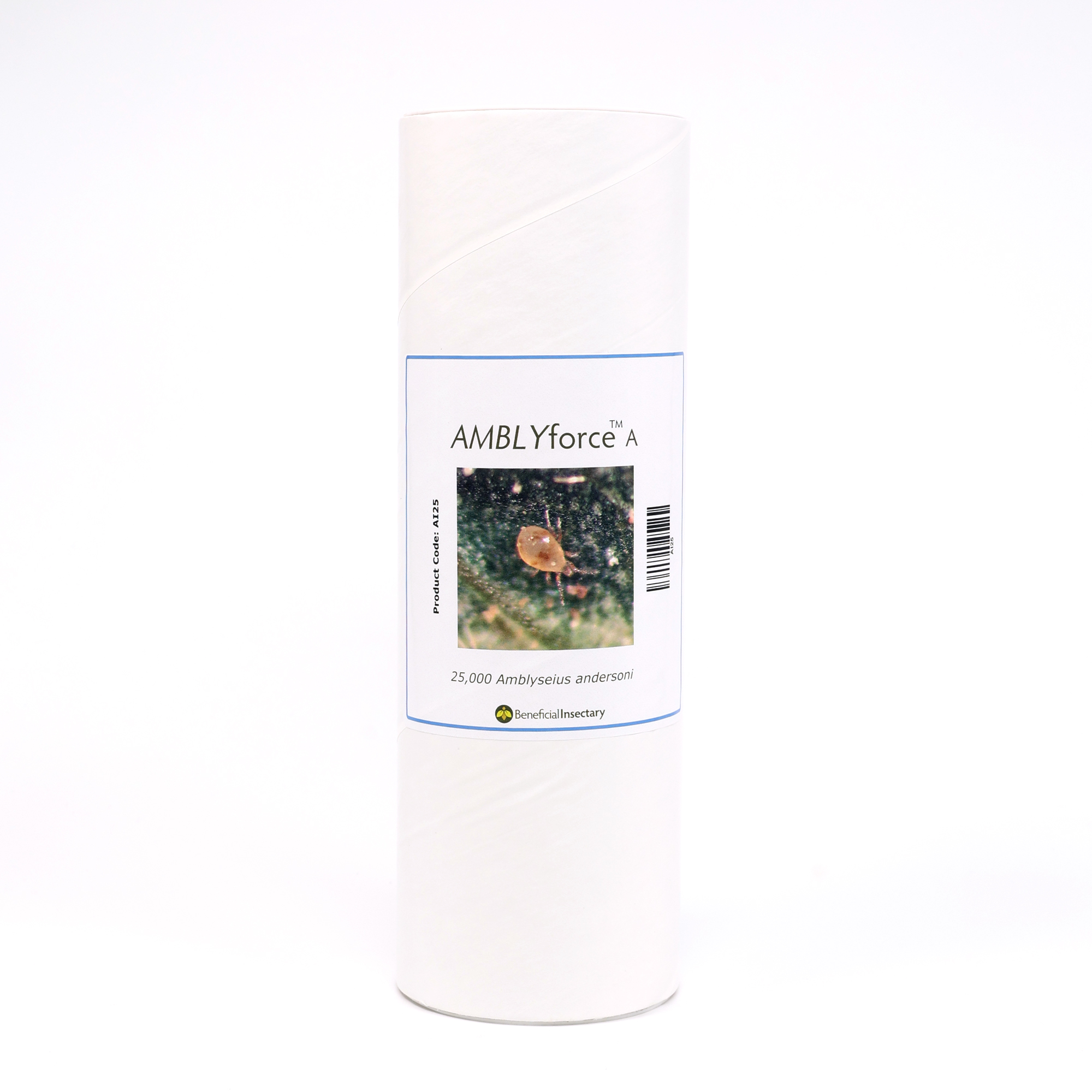AMBLYFORCE™ A
AMBLYforce™ A
AMBLYforce™ A is a predatory mite that feeds on many soft-bodied arthropod pests.
Amblyseius andersoni
Two-Spotted Spider Mite (Tetranychus urticae)
Carmine Mite (T. cinnabarinus)
Lewis Mite (Eotetranychus lewisi)
Banks Grass Mite (Oligonychius pratensis)
Broad Mite (Polyphagotarsonemus latus)
Russet/Gall/Rust Mite (Eriophyidae)
European/Citrus Red Mite (Panonychus spp.)
Thrips Larvae
Soft Fruits
Ornamental Crops
Hemp/Cannabis
Tree Nurseries
Greenhouses
Indoor Facilities
Fields
Gardens

All mobile stages are predatory, and they will feed on eggs, juveniles, and adults of spider mites. These mites can also survive on young thrips larvae, flower pollen, sugary excretions from pests, and fungi. Amblyseius andersoni should be introduced before the prey is present.
AMBLYforce™A is intended to be a preventative treatment for spider mites and other mite pests. Amblyseius andersoni is reported to be one of the first predatory mites to invade fruit crops after insecticide treatments are reduced.
Keep out of direct sunlight. Can be stored at 50-60°F. Use within 18 hours of receipt.
Mini Sachets with Hooks
Hang from plant branches, plant wires, or trellises. Do not hang adjacent to heating pipes. Although these sachets can handle some moisture, avoid prolonged moisture exposure, or let the bottom touch a wet area to prevent wicking. Sachets will continue to produce predatory mites for 4-5 weeks.
Shaker Tube
Shake small quantities of the product onto the crop near the flowers. You can also use URBs (Universal Release Boxes). These boxes can be placed within the crop like sachets on hooks to allow strategic releases while avoiding carrier litter on the crop. Place a small amount (no more than 1/3 of a box) of mites into each and hang where needed.
Check newest plant growth for signs of damage or webbing.
Check for any remaining webbing in the crop; the contents should be free of pest mites and eggs. Scouting for predatory mite adults can be difficult or impossible in many crops. Most predatory mites lay distinct eggs from pest mites which can help, but the most effective scouting method is to look for decreased pest pressure after releases. Predatory mites are fast-moving and usually not found in large numbers in the same area as pest mites. They often hide in the foliage and ambush their prey but occasionally traverse the upper leaf surfaces.
Apply AMBLYforce™ A when pest mite numbers are low, as these predatory mites will then be able to feed on small colonies of pest mites and prevent them from growing and causing significant damage to your crop(s).
Avoid exposing the sachets to direct sunlight for extended periods.
When you receive a sachet from Beneficial Insectary, they are filled with beneficial predatory and feeder mites. These allow for slow, constant releases of predatory mites over an extended period.
These sachets will last up to 5 weeks. Week numbers are printed on the back of each sachet. If your sachet is less than five weeks old, all you do is leave them in the plant. Sachets are water-resistant.
The mites reproduce inside and exit from a tiny hole in each sachet.
Sachets older than 5-weeks from today’s week can be checked for predatory mite activity but should be replaced even if observed. Sachets older than 5-weeks from today’s week can be discarded or left in the crop if removal is difficult.
Live-Product: Beneficial Insectary strives to guarantee the live delivery of the freshest organisms to our customers. We offer replacements or credits for any compromised shipments to our customers that report any issues or concerns within 24 hours. These issues or concerns must be relayed before releasing any organisms that are suspected of having viability issues. Please do not discard the product. You may be requested to return the shipment for further analysis.
Establishment of BCAs in Crop Settings: Many variables can negatively or positively impact BCA and pest populations in various crops we work with (pesticide applications, watering practices, improper storage methods, cultural/physical/mechanical controls, etc.). Some beneficial organisms require a steady pest presence as a food source to build their population. Others may require alternate food sources, such as pollen or nectar as an example. While other BCAs have specific photoperiod requirements for success. Due to these variables, we cannot guarantee the long- or short-term establishment of the BCAs we sell after the release of the organism(s). We will not offer refunds, discounts, or other credits on products that have already been released. Please adhere to our “Live-Product” disclosure.
PRODUCT RELEASE METHOD
PRODUCT SPECIFICATIONS
PRODUCT | PACKAGE SIZE Filler/Carrier | LIFE STAGES | PRODUCT CODE |
|---|---|---|---|
AMBLYforce™ A – 25,000
| 1 Liter Tube w/ Bran | Adults | AI25 |
AMBLYforce™ A – 62,500
| 250 Sachets (250ea) on a Hook w/ Bran | Adults | AI2H |
RELEASE RATES
CLASSIFICATION | RELEASE INFORMATION |
|---|---|
Preventative | 1-5 per 100 sq. ft., weekly |
Hot Spots | 5-25 per 100 sq. ft., weekly |
Life Cycle
EGG STAGE
- Eggs are approximately 0.15mm
- Murky white to beige in color
- Placed individually on leaves, most often on leaf hairs
- After 2-3 days, larvae emerge
LARVAL/NYMPHAL STAGES
- Amblyseius andersoni complete 1 larval and 2 nymphal instars before their final molt to the adult life stage
- Larvae are small and only have 6-legs
- Nymphal stages resemble adults with 8 fully formed legs, smaller overall size
- Juvenile stages are usually complete within 12-days of emergence
ADULT STAGE
- Amblyseius andersoni adults are 0.5 to 1mm in length
- Tear-shaped and light beige in color
- Adult life stage lasts approximately 3-weeks
- Female andersoni will lay between 25-30 eggs in her lifetime
